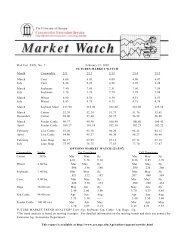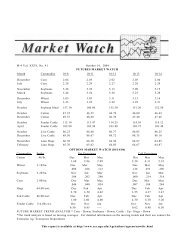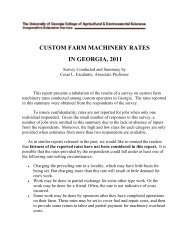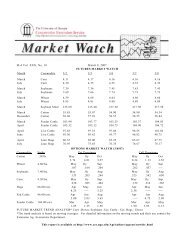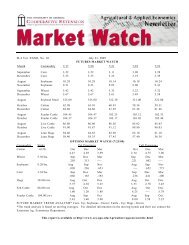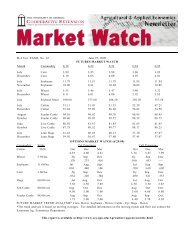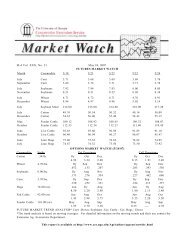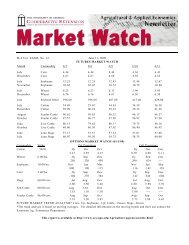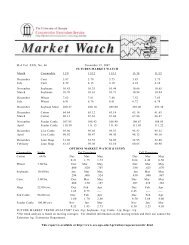Commercial Pepper Production and Management - University of ...
Commercial Pepper Production and Management - University of ...
Commercial Pepper Production and Management - University of ...
Create successful ePaper yourself
Turn your PDF publications into a flip-book with our unique Google optimized e-Paper software.
MARKETING<br />
<strong>Commercial</strong> <strong>Pepper</strong> <strong>Production</strong>,<br />
Marketing <strong>and</strong> <strong>Management</strong><br />
Esendugue Greg Fonsah<br />
Assistant Pr<strong>of</strong>essor <strong>and</strong> Extension Economist<br />
Department <strong>of</strong> Agricultural <strong>and</strong> Applied Economics<br />
<strong>University</strong> <strong>of</strong> Georgia<br />
Tifton, GA 31793<br />
Introduction<br />
Marketing pepper or any horticultural product is more than just selling. Marketing<br />
includes planning, production, harvesting, packaging, transportation, distribution<br />
warehousing <strong>and</strong> pricing. To be successful, marketing must be responsive to consumers’<br />
dem<strong>and</strong>s. Simplistically, it must be customer oriented. To add to the multifaceted<br />
problems, marketing skills are required <strong>and</strong> prior determination or knowledge <strong>of</strong> one’s<br />
targeted market is a necessary condition. Is it direct marketing, marketing to retail<br />
outlets, specialty food stores or wholesalers Do you need any promotion Is any<br />
specific harvest time required All these <strong>and</strong> more questions need to be addressed. Do<br />
consumers dem<strong>and</strong> quality, freshness, “reasonable” prices or all <strong>of</strong> the above<br />
Georgia <strong>Production</strong> <strong>and</strong> Farm Gate Value<br />
Georgia Agricultural Statistic Service (GASS) started collecting pepper data in 2000.<br />
Prior to that, most vegetable data was compiled by the <strong>University</strong> <strong>of</strong> Georgia, Center for<br />
Agribusiness <strong>and</strong> Economic Development. The information in Fig 1 is a combination <strong>of</strong><br />
both sources. Bell pepper is an important vegetable crop in the state <strong>of</strong> Georgia. The<br />
farm gate value data was gathered from various issues <strong>of</strong> the Georgia Farm Gate Value<br />
Report while the planted <strong>and</strong> harvested data was gathered from GASS. According to the<br />
Georgia Farm Gate Report, bell pepper ranked 24 th in 2004 amongst all Georgia<br />
Commodity Ranking as it generated slightly over $60 million.
Fig 1: Georgia Bell <strong>Pepper</strong> <strong>Production</strong> <strong>and</strong> Farm Gate Value, 2000-2004<br />
Acres<br />
6000<br />
5000<br />
4000<br />
3000<br />
2000<br />
1000<br />
0<br />
2000 2001 2002 2003 2004<br />
Planted A Harvested A. Farmgate<br />
100<br />
90<br />
80<br />
70<br />
60<br />
50<br />
40<br />
30<br />
20<br />
10<br />
0<br />
Million dollars<br />
Source: Boatright, S.R. <strong>and</strong> C. McKissick . 2004 Georgia Farm Gate Value Report,<br />
AR 05-01.<br />
The peak bell pepper farm gate value was recorded in 2003 when it generated over $87<br />
million <strong>and</strong> was ranked 18 th in the state. Planted acreage peaked in 2000 when about<br />
5200 acres were planted but only 5000 were harvested. The trend in planted versus<br />
harvested has been fluctuating (Fig 1).<br />
Wholesalers <strong>and</strong> Distributors Purchase Decision for Fresh Produce<br />
A 2002 <strong>University</strong> <strong>of</strong> Georgia marketing survey asked wholesalers <strong>and</strong> distributors to<br />
rank their purchase decision for fresh produce. The result is summarized in Table 1. It is<br />
not surprising that quality is the most important factor in the wholesalers’ <strong>and</strong><br />
distributors’ purchasing decision. However, it was interesting that quality <strong>and</strong> price were<br />
ranked higher than reliability. Unfortunately, the origin <strong>of</strong> fresh produce was ranked last.<br />
Table 1: Average Ranking <strong>of</strong> Wholesalers <strong>and</strong> Distributors Purchase<br />
Decision for Fresh Produce<br />
Importance <strong>of</strong> Specific Factors in Wholesalers/Distributors Purchase Decision for Fresh<br />
Produce -Ranked Most to Least Important<br />
(n=8)<br />
Factor<br />
Average Ranking<br />
Quality 1.13<br />
Price 2.00<br />
Reliability 3.63<br />
Quantity 4.13<br />
Convenience 5.00<br />
Transportation 5.25<br />
Origin 6.88<br />
Source: Wolfe, K <strong>and</strong> E.G Fonsah (2002) “Wholesales <strong>and</strong> Distributors Outlook For<br />
Fruit <strong>and</strong> Vegetables Produced in Georgia” GFVGA News Vol. 7, No. 4, Fall.
Wholesalers/distributors consider quality, price <strong>and</strong> reliability to be the most important<br />
factors in making a purchase. Being grown in Georgia will not help Georgia growers if<br />
their produce cannot compete on quality, price <strong>and</strong> reliability. These three factors are the<br />
minimal requirements needed to enter this market <strong>and</strong> can be thought <strong>of</strong> as a baseline<br />
from which grown in Georgia products must be differentiated.<br />
A Georgia survey asked buyers to rank the factors that influenced their decisions to buy.<br />
Georgia pepper growers have benefited from a growing market for peppers. Georgia's<br />
reputation for providing quality peppers in the quantity dem<strong>and</strong>ed has improved.<br />
Competition from other areas in the Southeast requires that this reputation be maintained<br />
<strong>and</strong> improved. As production continues to exp<strong>and</strong> some growers will not be able to<br />
compete. <strong>Production</strong> skills alone will not insure survival. Marketing will increase in its<br />
importance.<br />
<strong>Production</strong>, Domestic Consumption <strong>and</strong> Per Capita Use<br />
The United States production <strong>of</strong> fresh bell pepper is continually on the rise since 1978<br />
where only 520.1 million pounds were produced. By year 2003, production had<br />
increased over 3 times to 1680 million pound (Fig. 2). According to Lucier <strong>and</strong> Plummer<br />
(2003) production increased at an increasing rate until 1996 when it reached its peak at<br />
1664 million pounds. Thereafter, it has been fluctuating. However, years 2000 <strong>and</strong> 2003<br />
were as good as the peak year, 1996 as 1686 <strong>and</strong> 1680 million pounds were produced<br />
respectively (Fig 2).<br />
Fig 2: U.S. Fresh Bell <strong>Pepper</strong> <strong>Production</strong>, Domestic Consumption <strong>and</strong><br />
Per Capita Use, 1978 - 2003<br />
Million pounds<br />
2500<br />
2000<br />
1500<br />
1000<br />
500<br />
0<br />
1978<br />
1979<br />
1980<br />
1981<br />
1982<br />
1983<br />
1984<br />
1985<br />
1986<br />
1987<br />
1988<br />
1999<br />
1990<br />
1991<br />
1992<br />
1993<br />
1994<br />
1995<br />
1996<br />
1997<br />
1998<br />
1999<br />
2000<br />
2001<br />
2002<br />
2003<br />
<strong>Production</strong> Domestic Use Per Capita Use<br />
Source: ERS/USDA Vegetables & Melon/VGS-2003/July 2003, pg. 45.<br />
8<br />
7<br />
6<br />
5<br />
4<br />
3<br />
2<br />
1<br />
0<br />
Pounds
Domestic consumption equally increased almost 3.5 folds while per capita use increased<br />
over 2.5 folds concomitantly. In 1978, domestic consumption stood at 616 million<br />
pounds compared to 2083 million pounds in 2003. On the other h<strong>and</strong>, per capita use <strong>of</strong><br />
pepper increased from 2.8 pounds in 1978 to 7.1 pounds in 2003. Per capita use is “a<br />
measure <strong>of</strong> commodity disappearance on a per-person basis. Equal to total supply<br />
(production plus imports plus beginning stocks) less uses (exports, shrink <strong>and</strong> loss, seed<br />
use, ending stocks) divided by total U.S. population (including military)” (Lucier <strong>and</strong><br />
Plummer, 2003).<br />
Import, Export <strong>and</strong> Domestic Consumption<br />
Despite the over three fold increase in production, the United States still import a<br />
substantial amount <strong>of</strong> its pepper to supplement the ever increasing domestic consumption.<br />
<strong>Production</strong> (Fig 2) plus import minus export = Domestic consumption (Fig. 3). Although<br />
the United States also export pepper, total quantity imported surpasses export <strong>and</strong> this<br />
gap started widening since 1994 until present. <strong>Pepper</strong> export was at its peak in 1992<br />
when 189 million pounds were sold out <strong>of</strong> the United States. Thereafter, the export trend<br />
has been downward slopping. In 2003, only 162 million pounds <strong>of</strong> pepper were shipped<br />
out <strong>of</strong> the U.S. (Fig 3).<br />
Fig. 3: U.S. <strong>Pepper</strong> Import, Export <strong>and</strong> Domestic Consumption, 1978-2003<br />
600<br />
2500<br />
Million pounds<br />
500<br />
400<br />
300<br />
200<br />
100<br />
0<br />
1978<br />
1979<br />
1980<br />
1981<br />
1982<br />
1983<br />
1984<br />
1985<br />
1986<br />
1987<br />
1988<br />
1999<br />
1990<br />
1991<br />
1992<br />
1993<br />
1994<br />
1995<br />
1996<br />
1997<br />
1998<br />
1999<br />
2000<br />
2001<br />
2002<br />
2003<br />
Import Export Domestic Cons<br />
Source: ERS/USDA Vegetables & Melon/VGS-2003/July 2003, pg. 45.<br />
2000<br />
1500<br />
1000<br />
Domestic consumption has increased from 616 million pounds in 1978 to 2083 million<br />
pounds in 2003 (Fig 3). To meet up with this tremendous rising pepper dem<strong>and</strong>, import<br />
has become the talk <strong>of</strong> the day. In 1978, only 156 million pounds <strong>of</strong> pepper was<br />
imported to the United States compared to 565 million pounds in 2003, thus an increase<br />
<strong>of</strong> 262 percent. On the other h<strong>and</strong>, pepper export increased only 166 percent during the<br />
same time frame.<br />
500<br />
0<br />
Million pounds
<strong>Production</strong> <strong>and</strong> Seasonal Pricing<br />
Supply <strong>and</strong> dem<strong>and</strong> determine the general price level <strong>of</strong> pepper. Seasonal average prices<br />
per cwt have been fluctuating. In 1978 the seasonal average price per cwt was $19.4<br />
whereas in 2002 the price had jumped to $30.8 per cwt. The peak price was recorded in<br />
1998 at $34.8 per cwt (Fig 5).<br />
Fig 5: U.S. <strong>Pepper</strong> <strong>Production</strong> <strong>and</strong> Seasonal Prices, 1978-2003<br />
(Dollars per Cwt)<br />
1800<br />
40<br />
Million pounds<br />
1600<br />
1400<br />
1200<br />
1000<br />
800<br />
600<br />
400<br />
200<br />
0<br />
1978<br />
1979<br />
1980<br />
1981<br />
1982<br />
1983<br />
1984<br />
1985<br />
1986<br />
1987<br />
1988<br />
1999<br />
<strong>Production</strong><br />
1990<br />
1991<br />
1992<br />
1993<br />
1994<br />
1995<br />
1996<br />
1997<br />
$ Price/cwt<br />
1998<br />
1999<br />
2000<br />
2001<br />
2002<br />
2003<br />
35<br />
30<br />
25<br />
20<br />
15<br />
10<br />
5<br />
0<br />
$ per cwt<br />
Source: ERS/USDA Vegetables & Melon/VGS-2003/July 2003, pg. 45.<br />
<strong>Pepper</strong> prices vary greatly within a season <strong>and</strong> between years. Most <strong>of</strong> the price variation<br />
within season is caused by weather effects on production. Price variations among years<br />
are caused by changes in acreage <strong>and</strong> weather. Little <strong>of</strong> the price variation is caused by<br />
dem<strong>and</strong> changes. Dem<strong>and</strong> changes are slight from year-to-year. Fig. 5 further shows that<br />
despite the continuous increase in pepper production <strong>and</strong> supply overall price per cwt<br />
continues to rise concomitantly. This trend actually violates economic theory.<br />
For recent prices, see <strong>University</strong> <strong>of</strong> Georgia Extension Agricultural Economics website:<br />
www.agecon.uga.edu.<br />
Consumers determine the dem<strong>and</strong> by deciding what <strong>and</strong> how much they will buy. Thus,<br />
marketing efforts must be consumer oriented. Consumers normally reflect their wants in<br />
the product <strong>and</strong> product characteristics they buy. Characteristics <strong>of</strong> pepper quality<br />
include: shape, thickness, firmness <strong>and</strong> uniform glossy color. Variety <strong>and</strong> age determine<br />
color. The most preferred color is dark green. Specialty markets may dem<strong>and</strong> red, golden,<br />
or other colors. Large peppers normally bring premium prices, regardless <strong>of</strong> color. The<br />
competing states production levels determine the supply.
Conclusion<br />
Bell pepper is an important vegetable crop in the state <strong>of</strong> Georgia. It ranked 24 th in 2004<br />
amongst all Georgia Commodity Ranking as it generated slightly over $60 million. The<br />
peak bell pepper farm gate value was recorded in 2003 when it generated over $87<br />
million <strong>and</strong> ranked 18 th in the state. A 2002 <strong>University</strong> <strong>of</strong> Georgia marketing survey<br />
revealed that quality is the most important factor in the wholesalers’ <strong>and</strong> distributor’s<br />
purchasing decision. Quality <strong>and</strong> price were ranked higher than reliability.<br />
At the national level the United States production <strong>of</strong> fresh bell pepper has been<br />
continually on the rise since 1978 where only 520.1 million pounds were produced. By<br />
year 2003, production had increased over 3 times to 1680 million pound. Per capita use<br />
<strong>of</strong> pepper increased from 2.8 pounds in 1978 to 7.1 pounds in 2003. Despite the over<br />
three fold increase in production, the United States still import a substantial amount <strong>of</strong> its<br />
pepper to supplement the ever increasing domestic consumption. Domestic consumption<br />
has increased from 616 million pounds in 1978 to 2083 million pounds in 2003. The<br />
continuous growth in production <strong>and</strong> consumption <strong>of</strong> pepper in <strong>and</strong> out <strong>of</strong> the United<br />
States has indeed increased the dollar value from about $400 million in 1978 to almost<br />
$500 million in 2002. In 2002, pepper export value to Canada was worth $69.4 million<br />
equivalent to 94.5 percent <strong>of</strong> total United States pepper export value whereas $1.3 million<br />
was recorded for export to Mexico equivalent to 1.8 percent.<br />
Although the United States imported pepper from Mexico worth $122 million, $134.8<br />
million, $188 million <strong>and</strong> $132.7 million in years 1999, 2000, 2001<strong>and</strong> 2002<br />
respectively, bear in mind that Mexico also has comparative advantage in terms <strong>of</strong><br />
weather, cheap labor <strong>and</strong> other conditions over the United States. However, most <strong>of</strong> the<br />
firms producing <strong>and</strong> supplying fresh bell <strong>and</strong> chili pepper are United States companies<br />
based in Mexico <strong>and</strong> taking advantage <strong>of</strong> the cheap labor <strong>and</strong> favorable weather<br />
conditions simultaneously. In 1978 the seasonal average price per cwt was $19.4<br />
whereas in 2002 the price had jumped to $30.8 per cwt. The peak price was recorded in<br />
1998 at $34.8 per cwt. <strong>Pepper</strong> prices vary greatly within a season <strong>and</strong> between years.<br />
Most <strong>of</strong> the price variation within season is caused by weather effects on production.<br />
Price variations among years are caused by changes in acreage <strong>and</strong> weather.
References<br />
Boatright, S.R. <strong>and</strong> C. McKissick . 2003 Georgia Farm Gate Value Report, AR 04-01,<br />
The <strong>University</strong> <strong>of</strong> Georgia, College <strong>of</strong> Agricultural <strong>and</strong> Environmental Sciences, Center<br />
for Agribusiness <strong>and</strong> Economic Development.<br />
Boatright, S.R. <strong>and</strong> C. McKissick . 2004 Georgia Farm Gate Value Report, AR 05-01,<br />
The <strong>University</strong> <strong>of</strong> Georgia, College <strong>of</strong> Agricultural <strong>and</strong> Environmental Sciences, Center<br />
for Agribusiness <strong>and</strong> Economic Development.<br />
Georgia Agricultural Statistics Service/USDA. 2002 Census <strong>of</strong> Agriculture Georgia<br />
Pr<strong>of</strong>ile. Also see http://www.nass.usda.gov/ga/<br />
Lucier, G <strong>and</strong> C. Plummer (2003) “Vegetables <strong>and</strong> Melons Outlook” Electronic Outlook<br />
Report from the Economic Research Service, USDA, VGS-296, April 17.<br />
Lucier, G <strong>and</strong> C. Plummer (2003) “Vegetables <strong>and</strong> Melons Outlook” Electronic Outlook<br />
Report from the Economic Research Service, USDA, VGS-2003, July.<br />
Lucier, G <strong>and</strong> C. Plummer (2003) “Vegetables <strong>and</strong> Melons Outlook” Electronic Outlook<br />
Report from the Economic Research Service, USDA, VGS-298, Aug.21.<br />
Wolfe, K <strong>and</strong> E.G Fonsah (2002) “Wholesales <strong>and</strong> Distributors Outlook For Fruit <strong>and</strong><br />
Vegetables Produced in Georgia” GFVGA News Vol. 7, No. 4, Fall.



